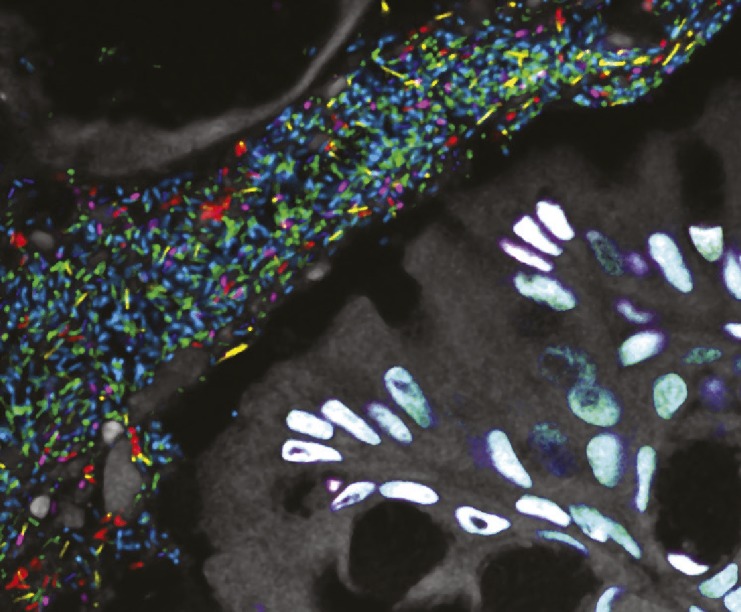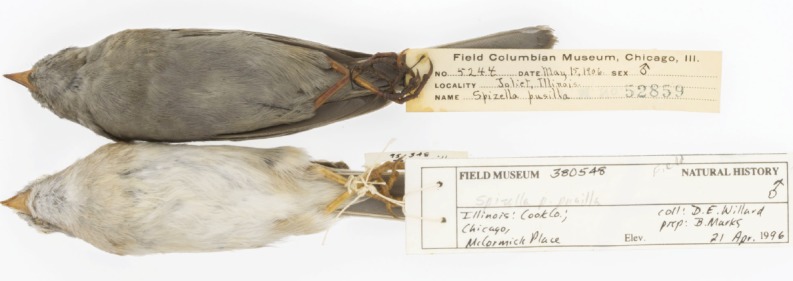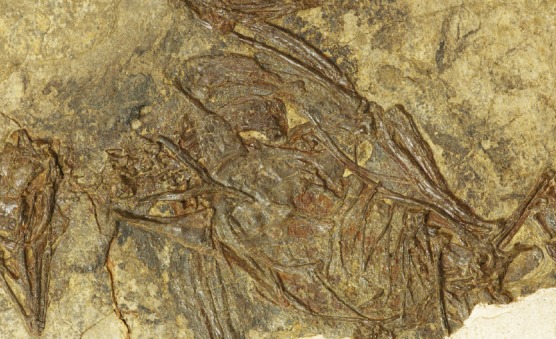Spatial structure of gut microbiota

Bacteria identified in the gnotobiotic mouse colon by fluorescence in situ hybridization.
The spatial organization of bacterial species within the gut is believed to influence the relationships among members of the gut microbial community and between community members and their hosts. However, the spatial structure of gut microbiota has been poorly characterized. Jessica Mark Welch et al. (pp. E9105–E9114) colonized adult germ-free mice with a mixture of 15 human gut-derived bacterial species, and used fluorescence in situ hybridization to simultaneously image multiple members of this consortium in cross-sections of mouse colon over scales ranging from a few micrometers to hundreds of micrometers. Bacteria were concentrated at the border between the intestinal mucosa and lumen and in mucus-rich patches in the interior of the lumen. At fine length scales, similar mixtures of bacterial species were observed in both luminal and mucosal habitats. Some spatial organization was observed within habitats; for example, Ruminococcus torques was depleted relative to other species in a narrow boundary region closest to host cells. According to the authors, the colon should not be considered as possessing sharply demarcated luminal and mucosal compartments, but instead might be described as an incompletely mixed bioreactor. Identifying host and microbial factors that contribute to bacterial mixing might provide insights into the role of the microbiota in health and disease, according to the authors. — B.D.
Olfactory tests, odor sensitivity, and cultural differences
Olfactory dysfunction—the inability to detect or distinguish odors—affects around 20% of the populations in Europe and the United States. Current diagnostic olfactory tests fail to account for individual olfactory sensitivity and prior exposure to specific odors. Hence, Julien Hsieh et al. (pp. 11275–11284) developed a pair of tests dubbed SMELL-S and SMELL-R for their ability to quantify olfactory sensitivity and resolution. Using mixtures of 30 monomolecular odorants that participants perceive as unfamiliar, SMELL-S gauges olfactory sensitivity by presenting participants with increasing dilutions of the test scents. SMELL-R introduces the concept of resolution to olfactory testing, measuring how well participants can discriminate between successive mixture pairs with an increasing number of shared components that render them progressively less distinct. As a proof of concept, the authors conducted trials with North American and Taiwanese participants, and present findings demonstrating that SMELL-S and SMELL-R accurately detect olfactory dysfunction without the need to account for individual and cultural differences. According to the authors, the tests might have potential clinical applications, such as the detection of olfactory dysfunction tied to memory loss in Alzheimer’s disease. — T.J.
Emergence of RNA on Earth
Given the widespread presence of RNA in living cells and its ability to store genetic information and self-replicate, RNA likely formed the foundation for life on Earth. Two competing hypotheses suggest that RNA might have evolved at hydrothermal vents in the deep ocean or in warm little ponds (WLPs), which have wet and dry cycles that promote nucleotide polymerization into RNA. Ben Pearce et al. (pp. 11327–11332) constructed a comprehensive numerical model for the evolution of nucleobases, nucleotides, and RNA in WLPs. The model uses sources, such as carbonaceous meteorites and interplanetary dust particles, to account for the supply of nucleobases to Earth. Additionally, the authors modeled various physical conditions of WLPs approximately 4.5–3.7 billion years ago, and used two temperatures—65 °C and 20 °C—to represent hot and warm conditions on early Earth. In each scenario, dry, intermediate, and wet environments were modeled. The results indicate that hot conditions supported rapid nucleotide synthesis in WLPs and that RNA polymerization occurred in one to a few WLP wet–dry cycles. According to the authors, the findings suggest that under WLP conditions RNA polymers likely appeared 4.17 billion years ago. — C.S.
Black carbon deposits on birds

Field sparrows from 1906 (Top) and 1996 (Bottom).
Combustion of organic matter, such as coal, generates atmospheric black carbon, which contributes to anthropogenic climate change. Estimates of early industrial emissions of black carbon are inexact, partly because black carbon sampling was uncommon prior to the mid-1950s. Using photometric reflectance data from museum specimens of birds collected from 1880 to 2015, Shane DuBay and Carl Fuldner (pp. 11321–11326) measured the relative concentration of atmospheric black carbon deposited on more than 1,000 birds, capturing concentrations from the year each bird was collected. The birds were originally collected within the US Manufacturing Belt, which was historically reliant on coal-burning industries and includes Chicago, Detroit, and Pittsburgh. The authors found that regional black carbon concentrations peaked during the first decade of the 20th century and were linked with coal consumption through midcentury. After 1960, black carbon concentrations and coal consumption became decoupled, likely due to more efficient coal burning, increased availability of other fuels, and regulations on coal consumption. Furthermore, the authors found that black carbon concentrations were higher than previous estimates for 1880–1910, but were consistent with previous estimates after 1910. According to the authors, the climate-forcing effects of black carbon may be underestimated. — L.C.
Bone fusion in primitive birds

Pterygornis. Image courtesy of W. Gao (Institute of Vertebrate Paleontology and Paleoanthropology, Beijing).
The skeletons of birds exhibit bone fusions in the hands, feet, and pelvis that make flight possible. However, due to a lack of transitional fossils and developmental studies in modern birds, the evolutionary history of bone fusion in birds remains unclear. Min Wang et al. (pp. 11470–11475) report a primitive bird specimen from the Early Cretaceous, around 120 million years ago, that displays a high degree of skeletal fusion in manus and pelvis bones. The bird, known as Pterygornis, belonged to the Enantiornithes, which represents what was likely the most diverse group of birds during the Mesozoic Era. The specimen exhibits bone fusion in the alular-major metacarpals and the ilium, ischium, and pubis pelvis bones, features that are rare in the majority of known birds from the Early Cretaceous. Osteohistological analysis indicates that Pterygornis followed a growth strategy exhibited by most modern birds, reaching skeletal maturity in approximately 1 year. The authors posit that the bone fusion morphology observed in Pterygornis might be due to a refinement of flight capability or genetic modifications in primitive birds. According to the authors, the findings shift backward the evolutionary timing for carpometacarpus and pelvis fusion in avians by more than 40 million years. — C.S.


